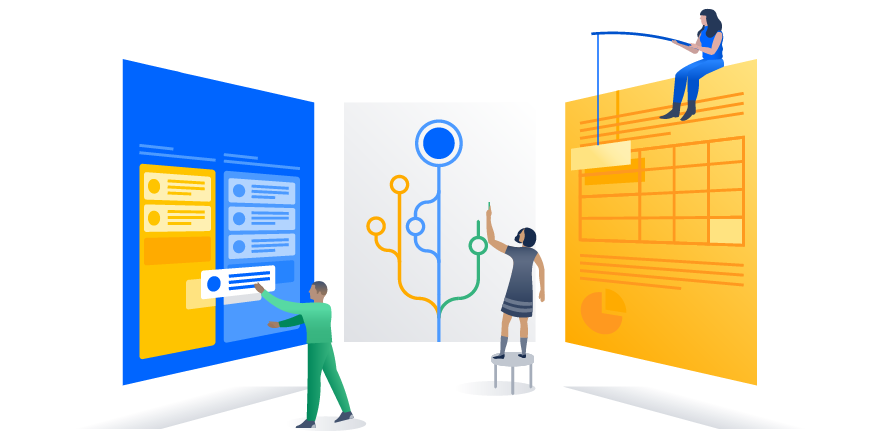In recent years, we’ve seen agile methodologies adopted by a variety of teams beyond software development, watched the rise of DevOps, and witnessed adaptations of agile across larger and larger organizations. It’s clear that in 2018, agile has reached mainstream adoption for companies large and small, across virtually every industry.
The outcomes of agile—higher quality software in users’ hands faster—are still as desirable as ever. But what’s next? We’d love to hear your opinion as part of our Retro on Agile. Every day, we’re learning what teams wish for, like, and wonder about with agile – and have collected some early commentary.
What the landscape of Enterprise Agile Planning tools illustrates
For a practice that values “individuals and interactions over processes and tools,” it can feel contradictory to discuss the most popular products and tools used to support agile.
However, getting a clear view of agile practices and its vibrant ecosystem of supporting tools helps us see how software development is evolving and improving, 17 years post-Agile manifesto.
That’s why we’re happy to announce that Atlassian is again a leader in the Gartner Magic Quadrant for Enterprise Agile Planning. With Jira Software, Portfolio for Jira, and the broader suite of Atlassian development tools, we are committed to making it easy for teams to adopt agile best practices across their organizations and scale them to the levels their organizations require. No matter what flavor of agile your teams uses, or how agile at your organization may be evolving, we want our products to help you release and iterate on great software.
Keep reading to learn more about the report, download a copy, and to hear about agile trends in 2018 and beyond.
Growing the impact of agile across an enterprise
As agile has become mainstream, the appetite for enterprise-wide adoption of these methods has increased. According to Gartner, “Agile adoption has traditionally been driven primarily from the bottom up, and enterprise-class agile development is a natural evolution of project-level agile to support the needs of large-scale software management … Top-down strategic adoption of agile is now growing, driven by digital business initiatives that demand the quick delivery of solutions to new types of problem.”
We believe that enterprises can and should embrace agile methods of working, but not at the cost of self-organizing teams or frameworks that restrict their growth. We’re excited to see teams who adopt scaled agile picking and choosing elements of existing frameworks that work best for their organizations and the individual teams within them.
We’ve also learned from you that enterprise agile means selecting tools that will scale with you, from both a visibility perspective and a performance perspective. We’re proud to help enable agile at enterprise scale, across teams tens of thousands strong. Our largest Jira customers, on average, have over 1,200 projects in Jira, and have tracked an average of 1.4 million issues. The scale of these teams and the the work they are delivering on behalf of their customers inspires us—we can’t wait to see what outcomes they deliver for their customers next.

What comes after agile?
We foresee almost everything about the process of software development becoming smaller, not larger. This transition started with agile, continues with DevOps and it will pick up speed “after agile.” After agile does not mean the end of agile, or signal a post-agile era. “After agile” represents a set of capabilities or advantages that the successful adoption of agile techniques affords you in the future. Rather than a reaction to waterfall development, the “after agile” era has emerged as an extension of agile.
The practice of building software — and software itself — is decomposing into smaller component parts and teams. Teams that are thriving in this era have first mastered agile practices and are now able to extend those practices to new architectures, new capabilities, and new teams involved in building software.
These new teams and architectures started to appear within the DevOps movement as virtualization and cloud computing changed the way Dev and Ops/IT worked together, eliminating the bottleneck and dependency on IT for hardware. The DevOps evolution has jumped from the purely technical teams historically associated with building software into related teams focused on putting working software into the hands of customers quickly. These teams are no longer just developers. Collaborators now include designers, marketers, product analysts, and data scientists.
This informs our belief that the future of software is driven by doing small, measurable things well, with frequency.
Without agile as a foundation, this newfound technical agility will be hard to harness. Combined, agile practices and new development technologies like microservices, continuous delivery, and feature flag management will usher in a new era of agility. In this next phase of agile development, product teams can adapt what customers see in production almost as fast as the customer feedback is generated.
Download the full report
For more detail on the adoption of Enterprise Agile Planning, including key industry trends and insights on agile tooling from Gartner, download the full report.
Gartner does not endorse any vendor, product or service depicted in its research publications, and does not advise technology users to select only those vendors with the highest ratings or other designation. Gartner research publications consist of the opinions of Gartner’s research organization and should not be construed as statements of fact. Gartner disclaims all warranties, expressed or implied, with respect to this research, including any warranties of merchantability or fitness for a particular purpose.
Gartner Magic Quadrant for Enterprise Agile Planning Tools, Keith James Mann, Thomas E. Murphy, Nathan Wilson, Mike West, 23 April 2018

